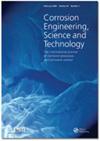硫氰酸根阴离子对钛在盐酸中的主动溶解和钝化膜的双功能作用
IF 1.5
4区 材料科学
Q4 MATERIALS SCIENCE, MULTIDISCIPLINARY
Corrosion Engineering, Science and Technology
Pub Date : 2022-07-15
DOI:10.1080/1478422X.2022.2099334
引用次数: 4
摘要
摘要使用动电位极化、电化学阻抗谱和电流瞬变技术,研究了在有和没有SCN−阴离子的情况下,钛在HCl中溶解和钝化的电化学行为。利用XPS和SEM工具对Ti氧化物膜的性质进行了表征。当HCl浓度、扫描速率和温度升高时,腐蚀电流i corr、临界钝化电流i cc和钝化电流i pass值显著增加。相反,SCN−阴离子的加入降低了i corr值,表明SCN−在Ti表面的吸附抑制了Ti的溶解。抑制效率随SCN−浓度的增加而增加。然而,SCN−阴离子会导致钝化区的钝化不稳定。Ti氧化物膜的形成是一种扩散控制的操作,如i–t曲线所示。根据XPS测量,钝化氧化物涂层主要由TiO2组成,较少由Ti2O3组成。本文章由计算机程序翻译,如有差异,请以英文原文为准。
The bifunctional role played by thiocyanate anions on the active dissolution and the passive film of titanium in hydrochloric acid
ABSTRACT The electrochemical behaviour of titanium dissolution and passivation in HCl was examined with and without the SCN− anions using potentiodynamic polarisation, electrochemical impedance spectroscopy, and current transients techniques. The nature of the Ti oxide film was characterised by utilising XPS and SEM tools. The corrosion current i corr, the critical passivation current i cc, and the passive current i pass values increased significantly when the HCl concentration, scan rate, and temperature were raised. On the contrary, the addition of SCN− anions decreases the i corr value, indicating that the Ti dissolution was inhibited as a result of SCN− adsorption on the Ti surface. The inhibition efficiency increased with increasing the concentration of SCN−. However, SCN− anions lead to destabilised passivity in the passive zone. The formation of the Ti oxide film is a diffusion-controlled operation, as shown by the i–t curves. According to the XPS measurements, the passive oxide coating consists mainly of TiO2 and less of Ti2O3.
求助全文
通过发布文献求助,成功后即可免费获取论文全文。
去求助
来源期刊

Corrosion Engineering, Science and Technology
工程技术-材料科学:综合
CiteScore
3.20
自引率
5.60%
发文量
58
审稿时长
3.4 months
期刊介绍:
Corrosion Engineering, Science and Technology provides broad international coverage of research and practice in corrosion processes and corrosion control. Peer-reviewed contributions address all aspects of corrosion engineering and corrosion science; there is strong emphasis on effective design and materials selection to combat corrosion and the journal carries failure case studies to further knowledge in these areas.
 求助内容:
求助内容: 应助结果提醒方式:
应助结果提醒方式:


